NPS is a popular customer experience metric used to gauge the strength of brands, customer loyalty, and future growth. NPS is a widely used metric. Yet, many companies do not always follow the best practices.
This blog post explains how to launch a successful campaign with NPS surveys:
We’ll focus on:
- The practical aspects of creating and dispatching surveys
- Survey data handling
- And, how to make the most of the customer feedback you collect from your NPS surveys.
We'll break down the process into 7 steps. Read on.

1.Pick the Right Tool for Your NPS Campaign
At the face of it, the technical requirements for setting up an NPS survey aren’t all that complex.
In theory, something as simple as Google Forms should do to run this simple survey. In practice, there are plenty of benefits of using a dedicated survey tool:
The ease of creation
NPS survey tools, like Survicate, enable you to create beautiful, on-brand surveys within minutes. Instead of fumbling around with tools that are not built for the job, they let you:
- Pick a template and either send it as it is or build on it.
- Embed your company logo to make the survey more on-brand and provide a better customer experience.
- Easily design the survey questions flow using skip logic and different question types in one NPS survey.
Omni-channel survey distribution and higher response rates
Survey tools let you send out your NPS survey through various channels: emails, websites, as well as web and mobile apps - to name a few.
Thanks to integrations with CRMs and marketing automation tools, you can embed survey links into emails and chat messages. You can also draw on the customer data to segment the respondents and send them personalized messages.
Good NPS tools offer you a large selection of communications channels and integrations. You include the NPS surveys in your customer journeys in a way that is convenient for your customers. So, you can yield better results.
Multiple integrations enhance feedback collection tools
Good survey software integrates with popular collaboration tools, marketing automation software, and CRMs. (Survicate integrates with tools such as Slack, Intercom, HubSpot, GetResponse, ActiveCampaign, Mailchimp, and many others.)
Thanks to these integrations, you can not only enjoy increased response rates and bigger data sample sizes but also streamline survey data handling:
The integration with Slack, for example, allows your customer experience-related teams to deal with survey responses as they flow in. So, they can quickly resolve urgent problems or act on opportunities that arise.
Other popular integrations with good collaboration tools are Google Sheets, Monday, or Airtable. They facilitate exporting and sharing survey responses and make feedback handling an integral part of your team’s workflow.
Real-time and advanced reports let you learn more
With a proper tool, you can check the real-time performance of your survey at any time. It lets you take the necessary actions if there’s need to improve your click-through rate.
In the case of Survicate, the tool also analyzes the survey responses and shows you repeating patterns. It's a cost saver as it lets your team save a lot of working hours they’d need to spend on analyzing the results.
Some feedback collection tools also record the responses in real-time. So, you can collect customer feedback even if a survey respondent drops out without submitting an answer to your follow-ups.

Moreover, advanced reports in dedicated feedback collection tools enable you to analyze the survey from different angles:
After filtering survey responses according to custom attributes (i.e., a survey answer, the size of an organization, a department, or a job title), you can uncover unexpected patterns and understand better what a given customer segment makes of your product or service.
2. Decide on the Target Group of the NPS Campaign
Now that you’ve chosen the survey software that best suits your needs, it’s time to roll up your sleeves and prepare the net promoter score campaign.
Start with choosing your target group and the right sample size:
The NPS campaign target group
The target audience will be limited by the goal of the survey, customer maturity and the last time you surveyed your customer base.
As to customer maturity -there’s no use in bothering new customers who have not yet familiarized themselves with your brand.
The goal of the campaign
When setting the goal of your NPS campaign, determine if you’re looking to find the overall NPS score across the entire user base or you’re interested in a given customer segment.
As far as the frequency is concerned - the only hard and fast rule here is that you don’t want to spam. A good practice is to survey a customer not more often than every 90 days. But at the end of the day, everything depends on your business type and the market you serve.
The sample size
Speaking of the sample size: A large sample gives you a more reliable result.
Assuming that an acceptable error margin is 10%, you need 250 survey responses to stay within the margin. With an average NPS surveys response rate of 15% - 30%, you’re looking to send your NPS survey to about 850 - 1,700 customers:

If you don’t have enough customers, account for a higher error margin. And, if in doubt, run additional tests before making new costly implementations.
3. Create an NPS Survey
Once you’ve chosen the tool, creating the survey is an easy part.
Tools like Survicate give you two options. You can either build a new NPS survey and start from scratch or:
1. Use a pre-defined survey template
Kick start your survey creation with an NPS survey template that you tweak to fit your needs. You can edit the net promoter question to adjust it to your brand’s tone of voice or the type of services or products you offer.
Feel free to use the free NPS Survey Template by Survicate:
2. Add follow-up questions
Add different types of questions - be it close- or open-ended ones. Use skip logic to make them appear logically, depending on how respondents answer.
3. Customize your survey
If needed, change the color palette and the background image. Add your company logo to enhance branding.
4. Translate your survey
Translate your survey to relevant languages. Make sure all questions, possible responses, and messages are phrased correctly. Some tools, like Survicate, offer the option of automatic translation. Noentheless, it's recommended a translator or native speaker proofreads all copy.
5. Adjust the survey settings to suit your needs
Enable or disable a progress bar, remove branding and add your company logo. If you’re going to send the survey by email, enable “Email answers confirmation” to filter the real survey responses from security robots.
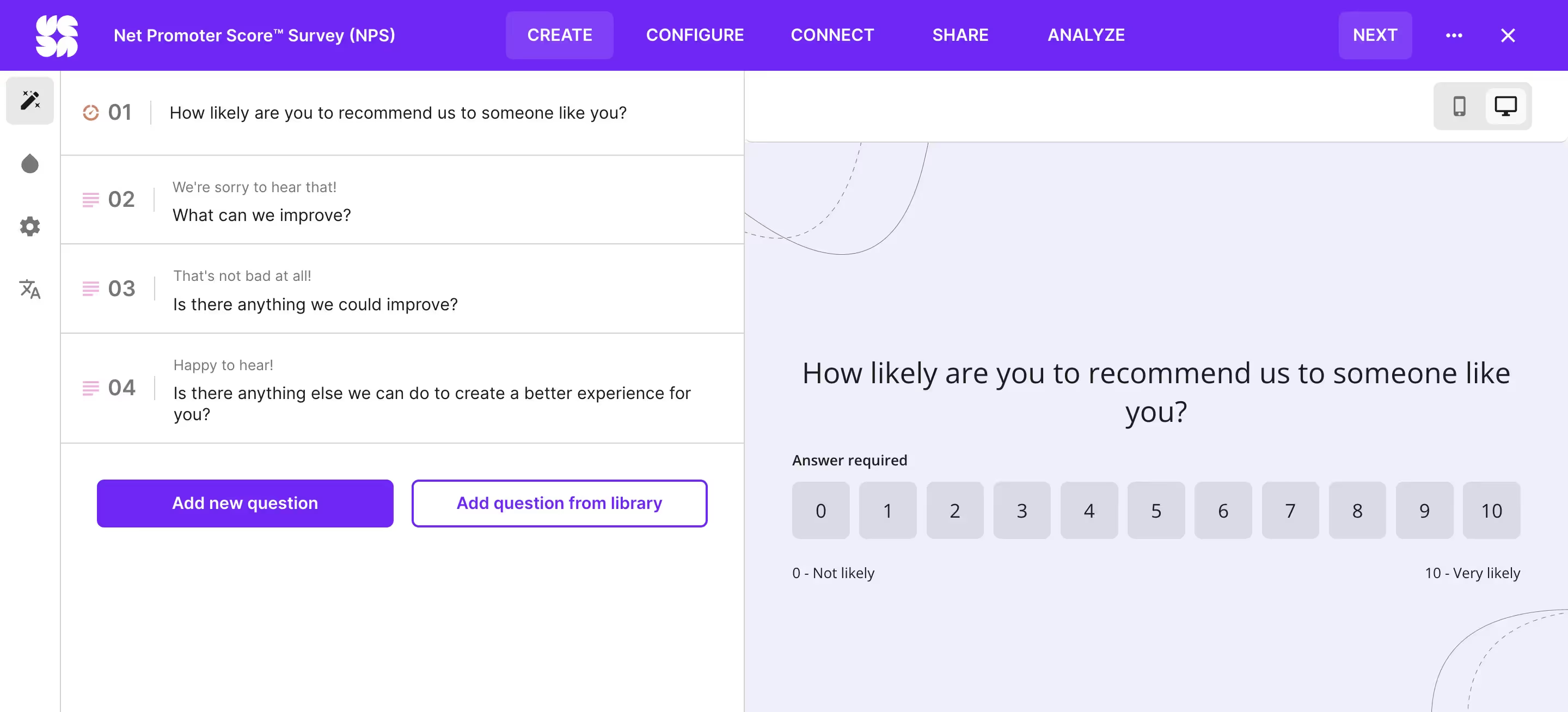
6. Configure the survey
Decide whether you want the NPS responses to be anonymous or you need to identify the survey respondents. If the latter, choose the CRM you’re going to use to access the information on your customers.
When configuring a survey, you can also decide how long you want the survey to run.
And you can limit the number of responses, which is useful if you have a large customer base. If you don’t need to send the survey to all customers to have a sufficient sample size, don't.
Set limits and send a survey to only a fraction of your customer base. This way, you’ll be able to get in touch with the remaining customers with a different survey sooner - without having to wait the minimum 90 days
7. Add integrations
Next, select the integrations you will need to deliver the survey and handle its results:
Connect the CRM you use - be it Intercom, Salesforce, HubSpot, or another customer relationship tool you use.) Think, where you want to collect the data. Are you going to store them in Google Sheets?
In the case of Survicate, you can also go for the Insights Hub. The tool lets you aggregate all the customer feedback data from your communication channels analyze and prioritize the feedback you collect.
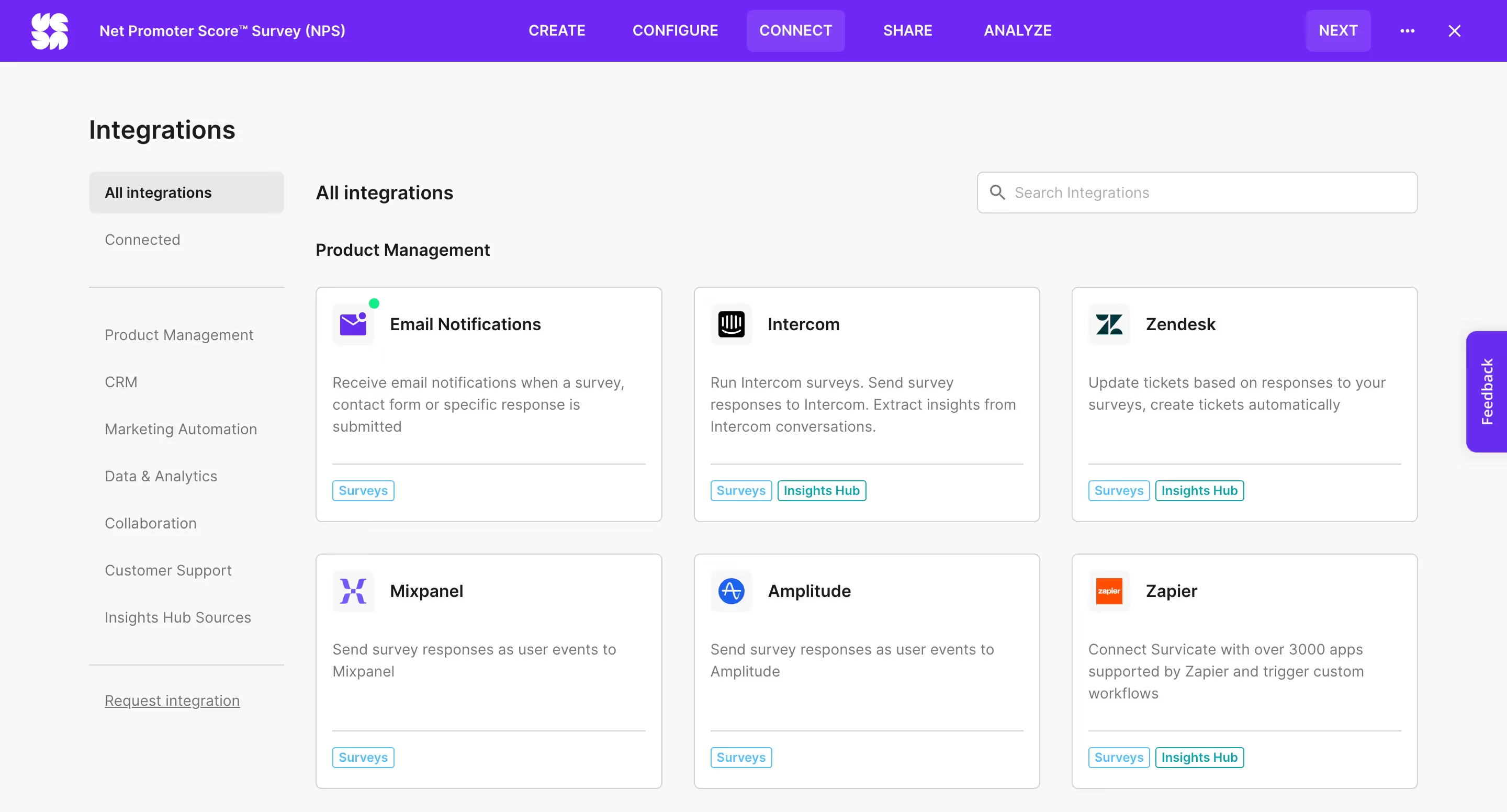
4. Send the NPS Survey
Feedback collection tools, like Survicate, let you choose the way you want to distribute your NPS survey. You can either:
- Email an embedded survey or a shareable link
- Set a pop-up survey on a website or in an app
- Share the NPS survey via Intercom messenger or another live chat.
When selecting the survey distribution channel, remember that it's bound to affect the survey's response rate you send.
Consider your user persona and the user journey map to choose the moments of truth that are most vital to your service. For example, sending in-product surveys works well when you measure NPS for SaaS. You also want to send the NPS survey when the interaction with it'll be least intrusive for your customers.
If you haven't researched your persona yet, we recommend using the following Buyer Persona Survey Template. Feel free to customize it the way you need
If you choose to send the NPS survey by email, know that embedding the survey in the email body increases the response rates. While an average response rate of a survey included under a CTA button is 26%, the number rises to 32% if the survey is visible in the email message!
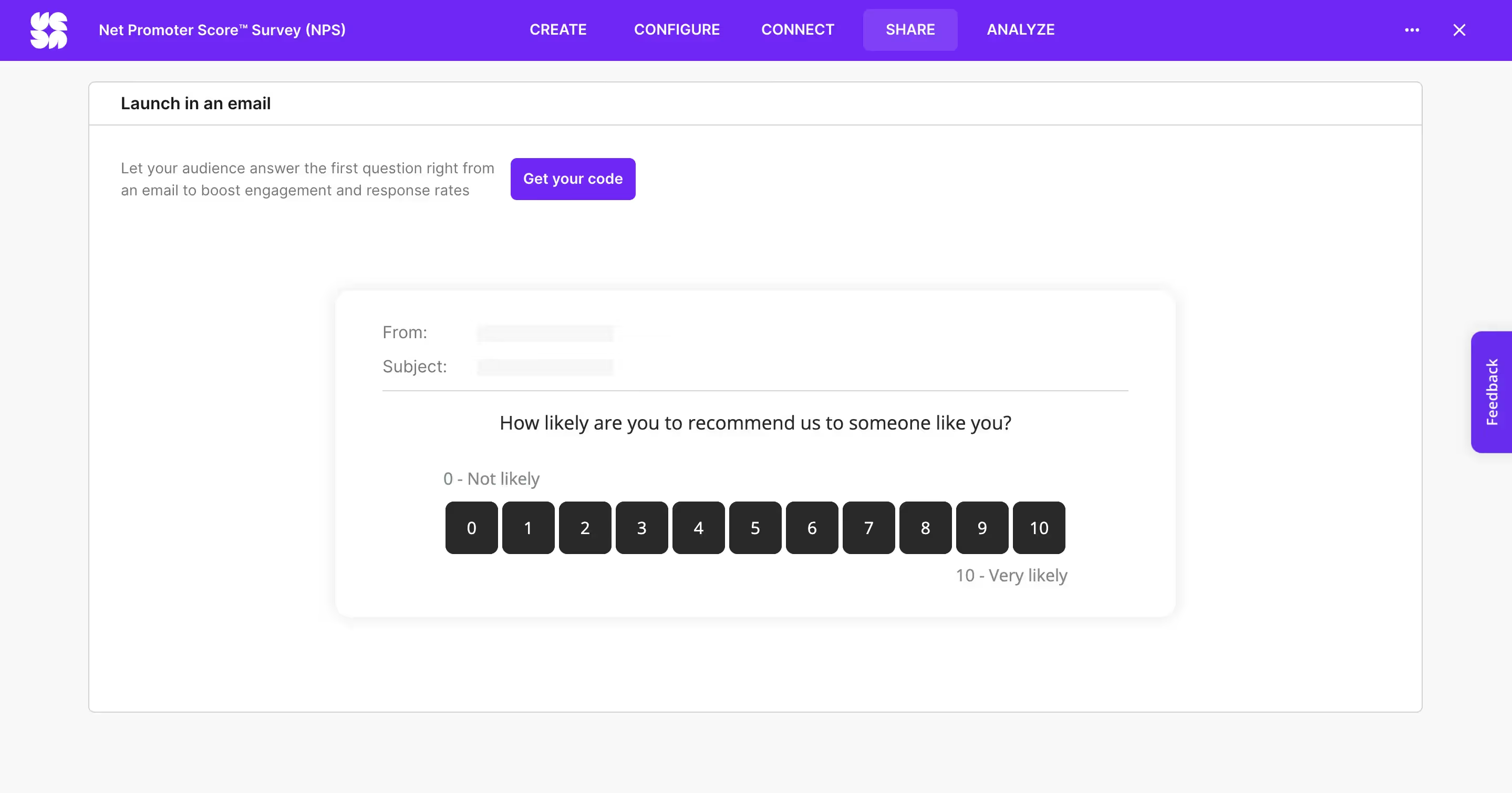
5. Calculate the NPS Score and Assess It Against Industry Benchmarks
If you go with Google Forms or a similar generic tool to create and launch your NPS survey, you'll need to calculate your NPS score manually or use an NPS calculator.
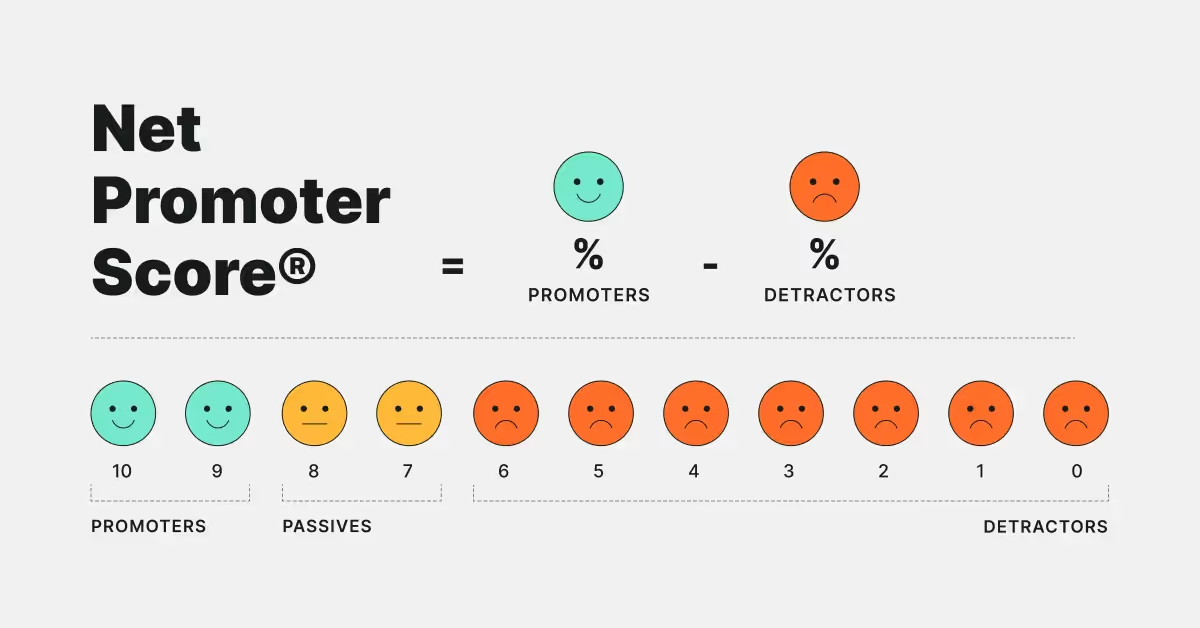
The process is even more straightforward if you run your NPS campaign with Survicate, as the tool tells you the final score.
But, what makes a good NPS score?
In an absolute sense, an NPS score from 0-30 is considered a good one. Such an NPS means promoters of your brand outnumber passives and detractors, even if by a fraction only.
Companies that invest heavily in improving a customer's experience can expect NPS scores between 50 and 70. Apple, for example - the top-of-the-mind successful brand customers love - used to have an NPS score of 72 (before it dropped to the current 47).
Does an absolute NPS matter?
Should you juxtapose your company's NPS with an absolute net promoter score (one that is considered good regardless of an industry)?
Opinions vary. Some experts claim that comparing your net promoter score to the one of the brands outside your industry makes little sense. An NPS score depends on various factors. So, what is considered a good Net Promoter Score score will vary, depending on a sector.
Rob Marey, who co-developed the concept of NPS claims that looking at the so called absolute NPS score is like comparing apples and oranges. He suggests assessing your NPS scores against your direct competitors' results.
And here industry NPS benchmarks come into play:
According to our NPS research, benchmarks differ across industries. Take a look at some of them:
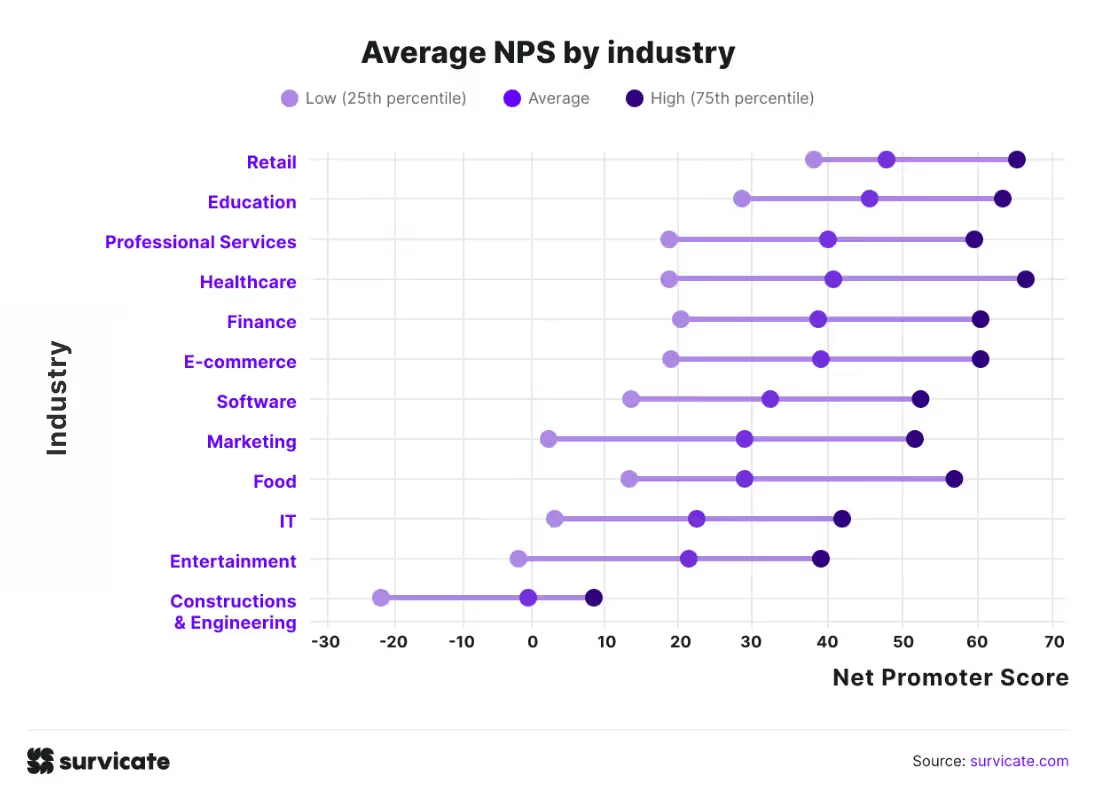
As you can see, net promoter averages vary. Healthcare is leading the pack. Retail, with a score of 48, is close behind. While construction and engineering are sitting at the very bottom of the list.
What can you infer from that?
The most apparent difference between retail and engineering is cost and risk. The transactions in the retail industry usually entail lower costs and much lesser risk. Higher costs mean higher prices that set up greater expectations, which are easier to let down. Big risk, in turn, provokes stress. When the risk and cost factors rise, so does the potentiality for dissatisfaction and unwillingness to recommend.
In healthcare, high net promoter scores may be linked to the relief people feel after being cured or the amount of attention they've received.
Those are important considerations. They may help you to find out what aspects of your service are most likely to affect customer satisfaction and the NPS score.
6. Set Up Notifications to React to Feedback Quickly
Best practices say it's best to respond to feedback within the first 24 hours. Without dedicated feedback software, it's virtually impossible to send personalized responses within such a time frame.
Software like Survicate, with its integrations, helps you automate the process. It offers notifications so that your team gets informed whenever a new piece of feedback appears.
Some feedback is more pressing than others. We recommend setting up custom notifications for every NPS score from a detractor and a promoter.
By setting them, your team we'll be able to act quickly on negative feedback - to alleviate the pain and prevent the escalation of the problem. They'll also be able to seize the opportunity positive feedback brings. More on this - later on in the article.
7. Close the Customer Feedback Loop
Closing the feedback loop is crucial to improving the customer experience. Even if not every piece of feedback will give you equal value, the fact that your customers took the time to respond to your survey matters. And it makes an opportunity to foster customer relationships.
So, should you get in touch with every single person who completes an NPS survey? Ideally, yes. How to do it calls for a separate article, so let us focus on reacting to NPS detractors and promoters here. The feedback from them should be your priority.
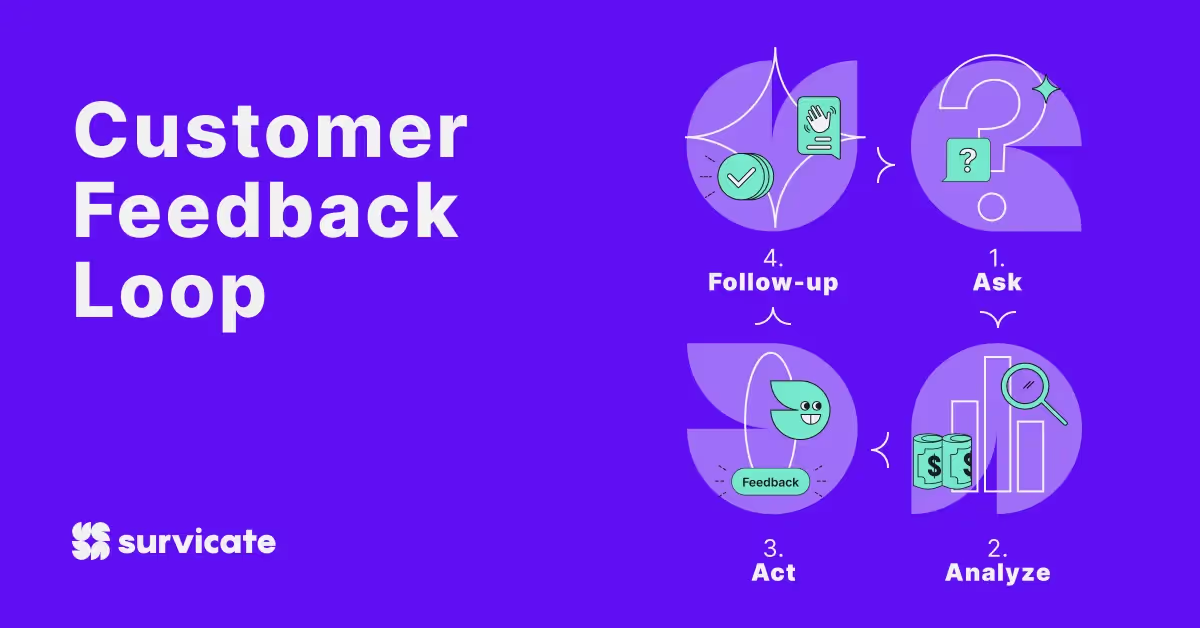
Respond to detractors' negative feedback to reduce churn
No one likes customer complaints. Yet, the input from detractors can be valuable feedback that speeds up the improvement of processes.
If your overall NPS score is low, dealing with detractors should be your priority.
As soon as a poor NPS comes in, make it a goal to contact the customers who gave you a low rating and find the precise reasons for their low score. If it can be addressed, take care of it immediately.
Detractors are the ones that most commonly churn. On top of that, if you let their disappointment fester, they are likely to bad-mouth you in online reviews sections and forums. So, dealing with unhappy customers' sores helps prevent churn and increase sales.
Not all the issues detractors raise can be resolved on the spot. As you prioritize NPS improvements, you may decide that some feedback you have to ignore.
Still, responding to feedback quickly and showing that you appreciate how customers feel can make a positive impact right away.
Leverage promoters in referral marketing to speed company's growth
Your happiest customers are your best brand promoters. So, if someone is ecstatic about the services you provide, seize the opportunity and act.
If a particular customer gives you a high NPS score, express your gratitude. Show that you appreciate having them as clients.
You may also tactfully point at other aspects of your offer they might be interested in. Show them that you solve even other problems that they have. Offering them a discount would be an excellent way to express thanks and foster their loyalty.
Finally, consider asking promoters to leave a review on your platform of choice. It's important. Customers trust online reviews as much as opinions from family or friends. So, personal recommendation is a powerful growth driver.
Happy customers rarely leave positive reviews on their own. That is why - seize the opportunity of interacting with them and ask them to actually recommend.
Wrapping Up
As you can see, a successful NPS campaign isn’t all that complex. All it takes is a proper process and, most importantly, the right NPS survey software. We recommend Survicate for everything we've named:
- Its ease of use
- Robust integrations
- Notifications that enable acting quick
- Powerful reports
Transform customer feedback into insights with Survicate's free account. During our 10-day trial, you'll have access to essential features. Sign up and take a look at our pricing.








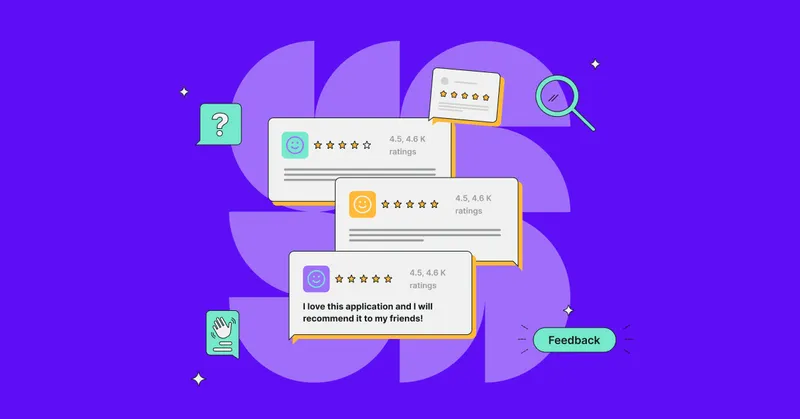
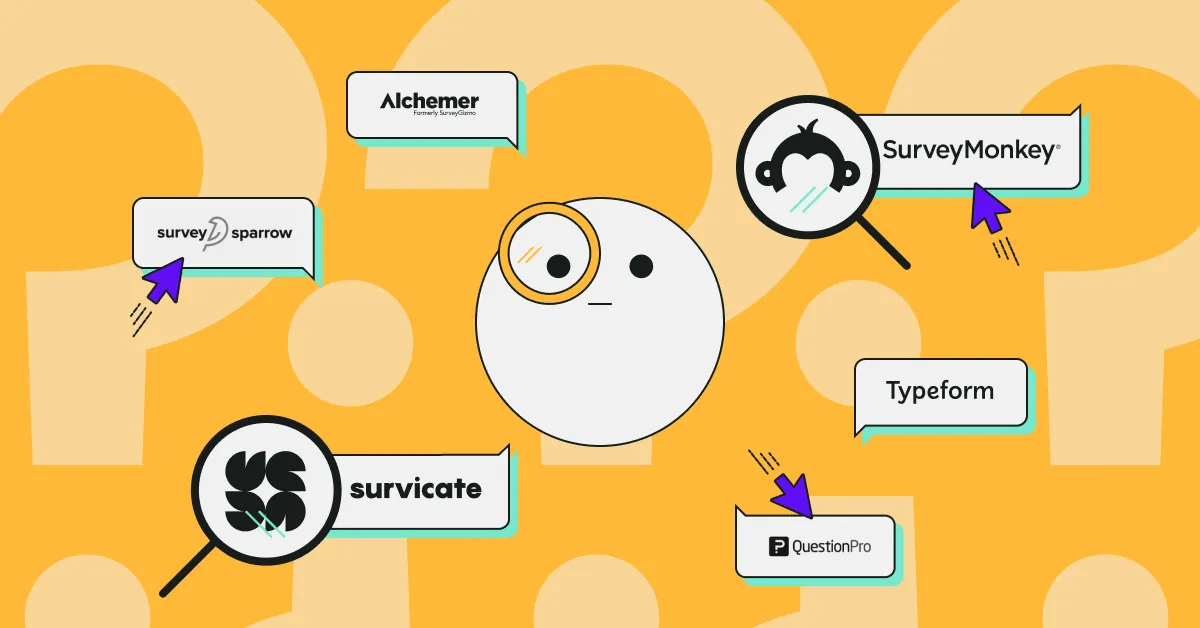

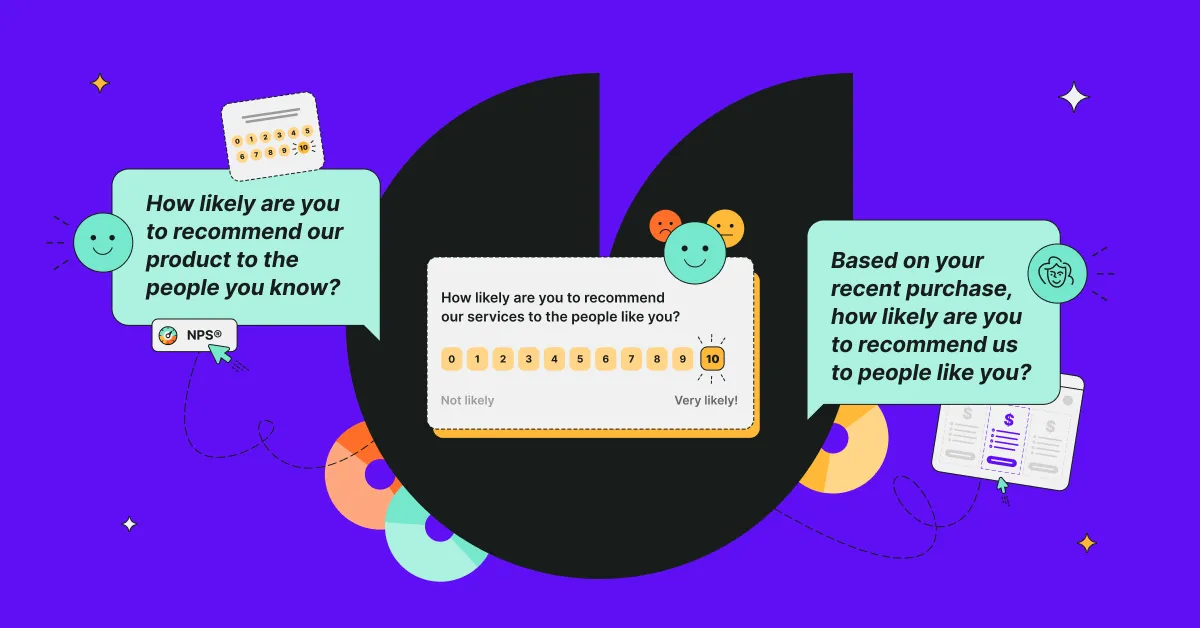
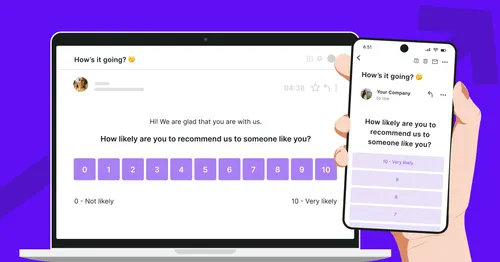
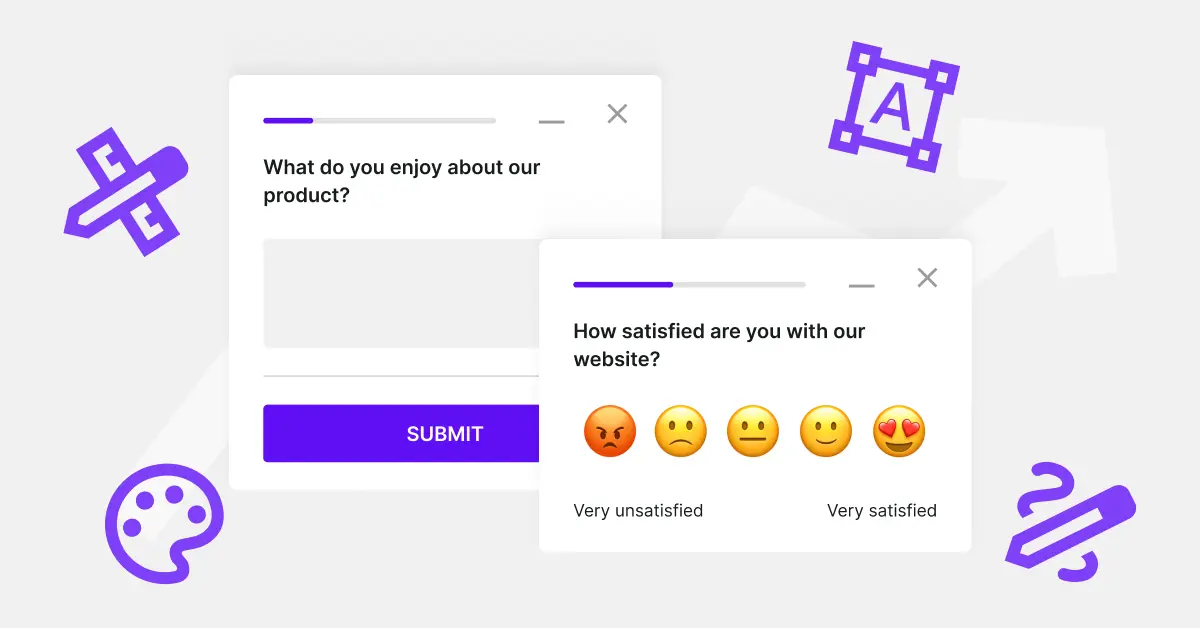
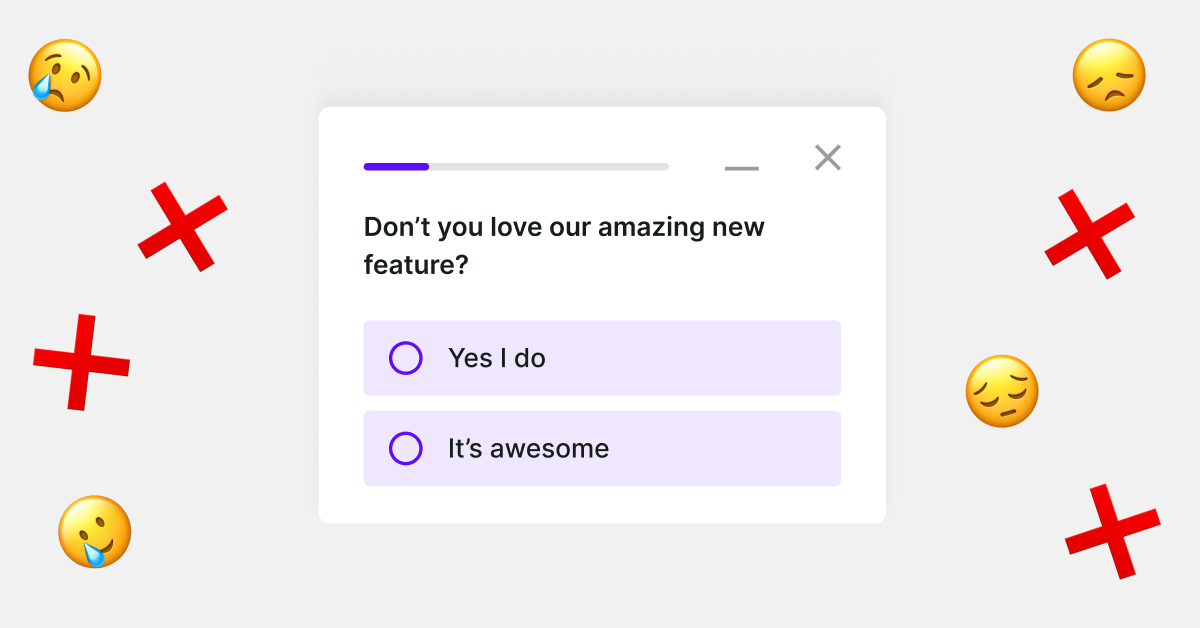
.svg)

.svg)



